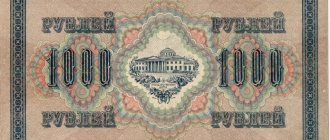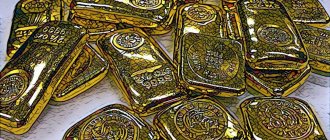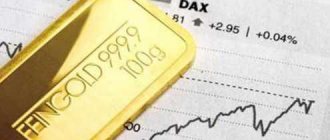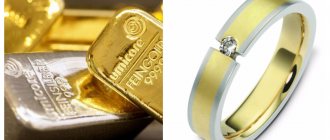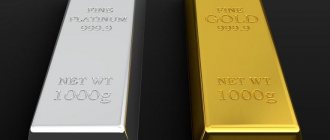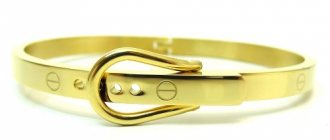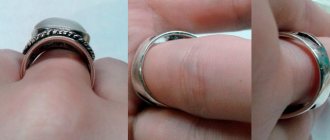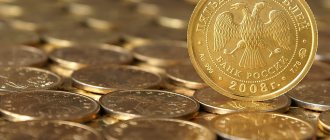What is the ruble backed by? Gold? Oil?
The ruble is not backed by any specific asset: gold, oil or anything else. There have been periods in history when currencies were backed by gold: directly (the “gold standard”, from the mid-19th century to 1944) or indirectly (the Bretton Woods system, from 1944 to the 1970s - then the main world currencies were pegged to US dollar, which in turn was pegged to gold). However, now most of the world's major currencies are provided with guarantees from the country's central bank: this body (the only one authorized to issue the national currency), with its power, enshrined in the country's legislation, guarantees that the currency will be accepted throughout the country as a means of payment. The Central Bank of Russia provides such guarantees for the ruble, the US Federal Reserve System for the dollar, the European Central Bank for the euro, and so on.
Who even decides that a ruble is cheap or expensive? Clerks at currency exchanges? But as?
Since November 2014, the ruble has become a free-floating currency, that is, the value of the ruble is determined on the market (currency exchange). As is the case with any other product, someone sells the ruble (supply), and someone buys it (demand). Accordingly, the more people want to buy the ruble, the more expensive it is, and the more actively the ruble is sold, the cheaper it becomes. Supply and demand for the ruble are determined by many factors (yes, not just the price of oil) - for example, an assessment of the risks associated with Russia. If the markets fear that new sanctions will be imposed on Russia or that the economic situation will worsen, the ruble will probably be actively sold. On the contrary, if the markets believe in Russia, believe that it is pursuing a competent economic policy and should not expect any bad news in the near future, the demand for the ruble will most likely increase and the Russian currency will begin to rise in price.
If the ruble depreciates, do prices in stores immediately rise?
No, not all and not at once. Some goods do not particularly depend on the ruble exchange rate - for example, if some product is entirely produced in Russia and does not require purchases abroad, the exchange rate will not affect it at all. An example is potatoes or cucumbers - their price depends much more on the season than on the exchange rate. Prices for cigarettes and vodka depend to a much greater extent on excise taxes, and prices on gasoline depend on the price of oil. Also, various services are suitable as an example - for example, the course does not greatly affect the cost of a haircut, a tennis section or a trip to a sanatorium in the Moscow region. On the contrary, the greater the role of imports for a particular product or service, the stronger the dependence on the exchange rate: foreign household and electrical appliances, foreign cars, snowboarding equipment or foreign tourism services are very susceptible to exchange rate fluctuations.
In general, to assess the impact of the exchange rate on prices, the so-called “pass-through effect” is used: a value that reflects how much a change in the ruble exchange rate affects inflation. In Russia, according to various estimates, the pass-through effect is now in the range of 0.1-0.15, that is, if the ruble depreciates by 10%, the overall price level increases by 1-1.5%.
It seems to have always been like this: if oil falls, the ruble falls. Does this rule work?
Not really. Oil growth does have a positive effect on the ruble exchange rate (and vice versa), but not everything is so simple. Firstly, as mentioned above, the ruble is influenced by other factors besides oil. For example, on April 9-10, oil rose, but the ruble fell, as concerns about new sanctions far outweighed the oil factor. In addition, the so-called “budget rule” now works in Russia - if the price of oil exceeds a certain established threshold (currently it is slightly above $40 per barrel), then the Ministry of Finance uses “extra” oil and gas revenues to buy foreign currency on the market. Thus, the impact of oil prices on the ruble is smoothed out: if the price of oil falls, the Ministry of Finance will buy less foreign currency on the market, and the ruble will strengthen. After all, the fewer purchases of foreign currency, the less demand for it. The less demand for foreign currencies, the lower their price. And the lower their price, the more expensive the ruble.
A cheap ruble is in some sense good, right? It is easier for the state to pay pensions.
Indeed, in the case of a weaker ruble, Russia receives more oil and gas revenues - after all, oil and gas prices are set in dollars, so the more rubles are given per dollar, the greater the country's revenues in ruble terms. So for the budget, a weak ruble is rather good. However, we must understand that a strong drop in the exchange rate leads to a surge in inflation and can threaten stability in the markets and in the economy as a whole, so a sharp depreciation of the ruble will clearly not benefit anyone. A cheap currency has its pros and cons, but too strong and sharp fluctuations (in any direction) are undoubtedly evil, not good.
What to do when you see a falling ruble? Buy euros? Or wait until it “rebounds”? How to solve this so as not to be left with a problem?
The most correct answer is to do nothing. Any economically literate person knows that the exchange rate (if it is floating) is essentially unpredictable and trying to “beat” the market is a generally useless exercise, especially for non-professionals. In any case, panic selling all rubles when it falls (and vice versa) is a bad tactic. It is very likely that within a few days the rate will “bounce” back - and then it will turn out that you have lost money.
The example of recent days is very indicative: against the backdrop of news about sanctions and confrontation in Syria, the dollar exchange rate by the middle of Wednesday, April 11, flew up from 58 to 65 rubles, but in the evening the dollar was worth 63 rubles, and on April 12 it dropped to 62. The first reaction of the markets In response to any unexpected events, you often panic, but you should never give in to panic. The most reliable tactic is to keep money in different currencies, and the share of your foreign currency savings should approximately correspond to the share of expenses for travel, purchasing goods abroad, and similar expenses. Then exchange rate fluctuations will not be so painful for you.
Will the falling ruble affect anything within the country? Or will it just become more expensive to travel abroad?
As mentioned above, the ruble exchange rate primarily affects prices - the weaker the ruble, the stronger the inflation. However, the influence of the course is not limited to this. A weaker exchange rate stimulates exporters - their prices on the world market become comparatively cheaper. And, on the contrary, it reduces imports - since the price for it, expressed in national currency, rises. Thus, the floating exchange rate of the national currency generally works as a “built-in stabilizer,” smoothing out shocks from external events (sanctions, falling oil prices, etc.).
This can be seen by comparing the last two crises: 2008 and 2014. In 2008, the ruble exchange rate in Russia was regulated, and the Central Bank sold currency, saving the ruble from collapse. Indeed, such a sharp drop in the national currency did not happen then, but Russia paid for it with a very strong decline in industry and GDP, as well as a noticeable jump in unemployment. From the point of view of economic activity, the last crisis turned out to be much less severe (for comparison: in 2009, industrial production in the Russian Federation fell by almost 11%, and in 2015 - by only 3.4%) and the reason for this was precisely the floating exchange rate.
How was the ruble secured?
The ruble as a monetary unit was introduced into circulation by Peter I and was minted from silver at that time. The raw material for the coins itself confirmed its status as a solvent unit. Then banknotes appeared in circulation, which very quickly depreciated and were not trusted even within the country. The only attempt to peg the ruble to gold was made at the end of the 19th century and ended very successfully.
Gold coins came into circulation and could be freely exchanged for paper money. The 1:1 ratio was not violated. In the pre-revolutionary period, the ruble's supply of precious metals reached 150%. This entire system, which was finally put into operation, collapsed after the revolution, when a political crisis reigned in the country and the economy was practically destroyed.
The fact that a currency is endowed with resources or a state reserve is usually assessed positively. According to world practice in recent years, a currency can be stable even without collateral. An example is the euro. This currency is not tied to the national economy, much less has any backing, but is quite successfully used and converted.
The Russian ruble is not backed by gold. Among the factors that provide the national currency, analysts name a large amount of foreign currency - the receipt of dollars from the sale of energy resources. Modern realities of geopolitics and economics force government authorities to think about stabilizing the ruble by other means. Is it possible to introduce backing of the Russian ruble in gold again?
What is gold?
In principle, the acceptance at one time of this element of the periodic table as a general commodity equivalent was also the result of a certain social contract, and therefore also conditional. Once upon a time, both Marx and Lenin pointed to certain conditions under which gold would lose its value, and the leader of the world proletariat predicted the construction (after the victory of world communism, of course) of latrines from the despicable metal in the largest cities of the world, which he saw as a certain symbolism. The metallic monetary system, of course, had many vices. Coins tend to wear out during circulation, and this causes them to lose weight. It is impossible to imagine a modern person taking out a bag of gold dust from a supermarket checkout instead of a credit card. In addition to payment properties, gold also has physical properties that give it technological significance. Finally, there is injustice associated with the unevenness of stocks among different countries. All this, however, did not prevent the introduction of gold backing of national currencies quite recently (in a historical sense), literally a few decades ago. What, exactly, has changed since then?
Found 10 years later: the miraculous return of Cuddly the cat
Teeth Whitening Powder: I've been using this simple recipe for years.
The Russian capital has become a leader in the world traffic congestion rankings in 2021
Is a return to the gold standard possible?
In the context of sanctions from Western countries and comprehensive pressure on the Russian economy, the idea of abandoning payments in dollars is heard more and more often and more insistently. As an analogue, a currency system based on collateral in the form of yellow metal is proposed.
Some actions of the Russian authorities indicate that work in this direction is underway. A weak ruble becomes a threat to the development of the domestic economy, prompting the Central Bank to raise rates. In the short term, the weakening of the ruble will not bring anything good, and the Central Bank of the Russian Federation cannot endlessly raise rates to protect the currency.
The situation is complicated by the sanctions imposed against Russia: the ruble has fallen over the past year against the dollar by more than 30%. The pricing of the ruble in American dollars occurs through foreign exchanges, which also does not strengthen Russia’s position. A currency war threatens serious economic problems, so many experts express support for the option of returning to the gold standard.
Options for creating gold collateral.
How can the ruble be pegged to gold? With the Russian economy at 2 trillion. US dollars, external public debt is about 378 billion. Foreign exchange reserves are approximately 429 billion dollars, of which about 45 billion are stored in the form of real precious metal. The budget deficit will be about 1% of GDP in 2015. These conditions suggest that the gold standard can be introduced and successfully used for a long time. The two main conditions for its success will be strict adherence to budget discipline and strict control of the credit sector.
One option could be the issue of coupon bonds, the yield on which will be tied to gold.
Managing the ruble exchange rate under the gold standard will cause some difficulties, but with the competent work of the Central Bank, they can be resolved. Lending growth will have to be limited, otherwise the entire created system will be at risk. The massive conversion of rubles into precious metals can be regulated by withdrawing the currency from circulation.
The main threat to the gold backing of the ruble is the central banks in London and New York, which can buy rubles and present them for exchange for the yellow metal. But this possibility can also be limited by introducing special rules.
It is unclear whether the ruble will be backed by gold or other collateral in the near future. The assessment of the consequences for the country's economy is as follows: with the introduction of the gold standard, the ruble should stabilize. This will mean that the increase in the cost of living will slow down markedly, and domestic savings will begin to grow. Ideally, this could lead to political consequences: lower government spending on social security, the establishment of monetary stability and low taxes. All this should create conditions for the creation and further development of a strong production basis for the domestic economy.
Difference #3
Another system. The economy in the USSR and the economy in Russia are different things. The USSR had an administrative-planning model; we can say that the USSR was completely self-sufficient. Moreover, the USSR was considered a superpower, where almost the main key industries were developed. In the USSR there were three types of ruble:
1. Foreign exchange – for settlements with foreign partners.
2. Cashless.
3. Cash.
Each had its own function. The Soviet ruble was never a way to accumulate money and receive super-profits. Therefore, the Soviet ruble was used only for mutual settlements, as well as improving the lives of people and the state, and making a profit did not play an important role. Now everything happens completely differently. Now the market model and the main goal of entrepreneurs is to get as much profit as possible.
Critical look!
Some experts view the return to the gold standard critically. The history of economics knows positive examples of such government actions, but now is a completely different time. Factors that correspond to the actual state of the economy should be taken into account.
Monetary-type inflation will create uncertainty risks for capital investments and effectively destroy savings, which are vital for financing. Some believe that currency management cannot lead to economic growth.
But the real situation is that if the countries with the largest economies in the world begin the transition to the gold standard, this will mean one thing - the end of the dollar-based currency system. Whether the ruble will be tied to physical gold or not depends on the decision of government authorities. The decision must be made taking into account the size of actual budget expenditures and the presence of long-term obligations.
Such steps by individual countries will lead to a split into two camps: some will use the gold standard, while others will not be able to do this or simply will not want to take this step.
Among those states that can do this and are systematically preparing for the introduction of the gold standard is China. The demand for gold from China in recent years has always been one of the highest; government policy is aimed at accumulating gold reserves and stimulating private investment in the metal. These measures allow the Chinese economy to protect itself from external and internal negative factors.
Chinese authorities often blame American policy for the current situation in the gold market. The US is using its huge gold reserves to suppress other currencies in order to maintain the dollar's leadership. Further strengthening of the Chinese economy may allow the internationalization of the yuan, which will become a competitor to the dollar.
There is another opinion regarding the introduction of the gold standard. Economists say that such a monetary system will not be sustainable, since the supply of money will be controlled not by banking institutions, but by mining companies. The price of gold will constantly change, especially depending on the discovery of new deposits of the precious metal, and inflation will be replaced by deflation.
This development of events is possible, but has several open questions. The rate of gold production is growing much slower than the US Federal Reserve's money printing is increasing. Such actions always lead to inflation and undermine the stability of the monetary system. Under the gold standard, it is simply impossible to make money indefinitely.
The Ingredients of Prosperity
Of course, the key to the prosperity of the Russian Empire at the turn of the nineteenth and twentieth centuries were, in addition to the “golden reform,” other macroeconomic measures. Equilibrium fiscal policy, export expansion (in particular grain, oil was not as important then as it is now) and customs and tariff legislation developed by D. I. Mendeleev contributed to enormous success, replenishment of the treasury and strengthening of the state. But there was also a basis according to which it became impossible to depreciate the population’s savings, distrust in the national currency and Russia’s dependence on external circumstances. Prices for any goods could fall or rise, but the ruble remained a ruble. Until 1917.
White and brown. The girl decided to renovate the house of her youth
Licorice root has been proven to neutralize Covid, but too much is also harmful
Canadian finds bottle with diamond ring and note
conclusions
Is the Russian ruble backed by physical gold? No, today Russia does not have a monetary system based on the gold standard. Theoretically, such a fundamental economic decision can be made; the current geopolitical situation and the state of the gold market allow this to be done. Such measures will require strict regulation of the credit sector and a systematic policy regarding the regulation of the ruble exchange rate from the leadership of the Central Bank.
If you find an error, please select a piece of text and press Ctrl+Enter.
"Golden" reform
In Russia, gold content was introduced by law in 1896. The greater the supply of precious metal in the vaults, the more paper notes and banknotes the state treasury could issue (issue). In special, crisis cases, the State Bank could increase the volume of money supply by 300 million rubles, but, by the way, it never used this right; there was no need. Along with paper tokens, there were also coins, gold chervonets, silver fifty dollars and rubles. The inhabitants did not really like to use them - it was difficult and inconvenient. Each ruble, regardless of its appearance, was equivalent to 0.7 g of gold, pure gold, excluding impurities. That is why the Russian currency was willingly accepted by all parties to trade agreements without restrictions, both at the private and government levels.
Reasons for canceling chervonets
At various points in history, most often during a crisis, precious metal coins had to be temporarily withdrawn from circulation. Securing money with gold has many advantages, among which the main ones are high density, small storage volume, stability, uniqueness and other qualitative characteristics of the precious metal.
However, later gold coins had to be abandoned completely for a number of reasons:
- Chervonets of high standard had increased softness, were easily scratched, and deteriorated when frequently checked for authenticity by biting. Coins were often lost, which upset the balance of free circulation of money.
- The rapid growth of trade turnover could no longer be ensured by minting coins in the required volume.
- The large weight and small volume are convenient for storage, but caused a number of inconveniences during transportation. Even a small purse of gold was extremely weighty.
This led to gold being kept in the treasury, and paper money becoming a kind of certificate for it. After the abolition of the standard in the United States (1971), almost all countries abandoned their currency peg to gold.
